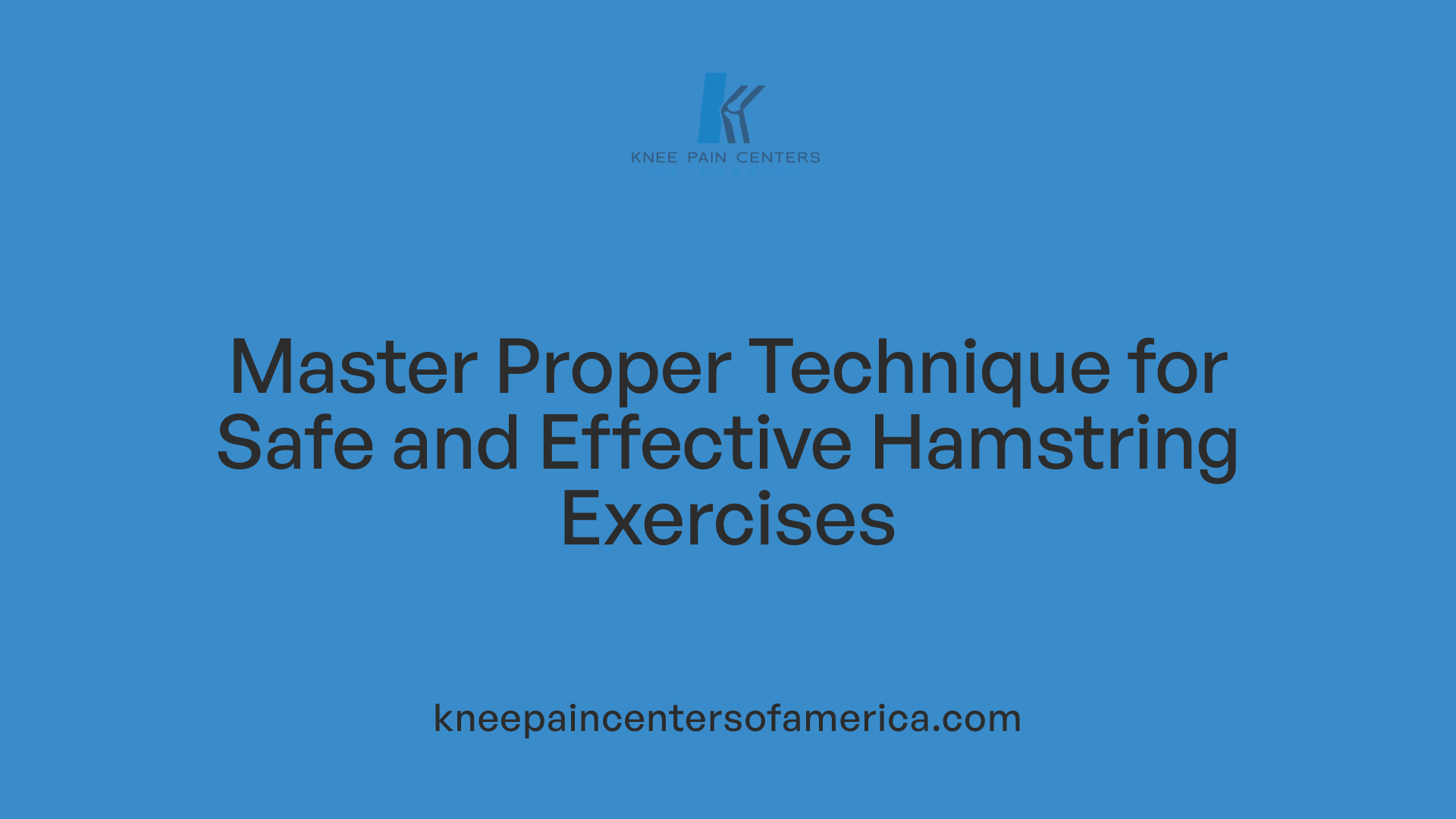Introduction to Resistance Band Hamstring Training
Hamstring muscles, located at the back of the thighs, are crucial for various lower-body movements including running, jumping, and stabilizing the hips. Strengthening these muscles is essential for athletic performance, injury prevention, and improving overall lower body functionality. Resistance bands offer a versatile, cost-effective, and accessible way to target and develop the hamstrings, whether at home, in the gym, or on the go.
Benefits of Using Resistance Bands for Hamstring Training
How do resistance bands benefit hamstring training?
Resistance bands are highly effective tools for strengthening the hamstring muscles because they provide consistent tension throughout each movement. This continuous resistance ensures all parts of the hamstring are actively engaged, leading to better muscle activation and growth. They are particularly useful for isolating muscles during exercises like hamstring curls, bridges, and deadlifts, which can be performed easily at home.
One of the main advantages of resistance bands is their ability to facilitate progressive overload — the gradual increase of resistance over time, which is essential for muscle development. As users grow stronger, they can switch to heavier bands or increase repetitions, ensuring ongoing progress.
Besides strength gains, bands also promote flexibility and improve the range of motion in the hamstrings. Stretching and strengthening with bands can enhance joint flexibility, which is key for injury prevention.
Another significant benefit is the convenience they offer for home workouts. Unlike bulky gym equipment, bands are portable, inexpensive, and easy to store, making consistent training more accessible. This flexibility helps maintain regular exercise routines regardless of travel or schedule constraints.
Using resistance bands also aids in correcting muscular imbalances. Often, one hamstring may be weaker than the other or underdeveloped compared to the quadriceps. Incorporating band exercises ensures balanced muscle activation, reducing injury risks such as strains and sprains.
Furthermore, regular band training enhances posture and functional strength. Stronger hamstrings support proper alignment and stability during daily activities, athletic pursuits, and ergonomic postures, contributing to overall lower-body health.
In summary, resistance bands benefit hamstring training by fostering muscle engagement, enabling gradual strength increases, expanding mobility, and offering convenience for consistent training. They not only help in muscle development but also support lower limb stability, injury prevention, and functional fitness.
Effective Hamstring Exercises Using Resistance Bands
What are effective hamstring exercises using resistance bands?
Resistance bands are a practical and versatile tool for strengthening the hamstring muscles. Some of the most effective exercises include lying hamstring curls, seated hamstring curls, and prone hamstring curls. These exercises isolate the hamstrings, helping to promote muscle growth and improve strength.
Romanian deadlifts performed with resistance bands are excellent for targeting both the hamstrings and glutes through hip hinge movements, similar to traditional weightlifting but with the added benefit of adjustable resistance. Nordic hamstring curls are another highly effective exercise that focuses on eccentric strength of the hamstrings, crucial for injury prevention and enhanced muscle control.
In addition to these, movements like donkey kicks, pull-throughs, and glute bridges with resistance bands are beneficial for overall posterior chain development. These exercises combine hip extension with hamstring engagement, leading to balanced muscle activation.
For optimal results, training hamstrings with resistance bands should be done twice a week, allowing at least 48 hours between sessions. Incorporating a variety of rep ranges—from as low as 6 to as high as 20—can develop strength, endurance, and muscle size.
Resistance bands continuously provide tension throughout each movement, making them more effective at activating muscles compared to traditional bodyweight exercises. Their portability and adjustable resistance levels also allow individuals to progress gradually as strength improves.
Overall, combining these exercises into a balanced routine can significantly enhance hamstring strength and endurance, supporting better movement mechanics and injury resistance.
Proper Technique for Banded Hamstring Exercises

What is the proper technique for performing hamstring exercises with resistance bands?
Performing hamstring exercises with resistance bands effectively and safely requires attention to technique and form.
First, securing the resistance band correctly is essential. For exercises like the lying or seated hamstring curl, anchor the band to a sturdy, low point such as a secure attachment on a door or a piece of heavy furniture. Alternatively, for standing movements, you can step onto the band with your feet, ensuring it provides enough tension during the movement.
Maintaining proper posture is crucial throughout your workout. Keep your back straight and engage your core muscles to support your spine. Whether performing curls or deadlifts, hinge at the hips with a slight bend in the knees, and avoid rounding your shoulders or arching your back.
Controlled movement and consistent tempo make a significant difference. Focus on slow, deliberate motions to maximize muscle activation and minimize injury risk. During hamstring curls, for example, curl your heels towards your glutes smoothly while keeping your hips stable. In exercises like Romanian deadlifts, lower the weight slowly while maintaining a neutral spine, feeling the stretch and contraction in your hamstrings.
Specific techniques differ depending on the exercise. For seated hamstring curls, lie face down, loop the band around your ankles, and curl your heels back along the floor without jerking. For glute bridges or donkey kicks, place the band around your thighs, lift your hips or leg with a controlled motion, ensuring your glutes and hamstrings work together.
To increase resistance, you can switch to a heavier resistance band or adjust your position to create more tension. For example, stepping further onto the band or increasing the distance from the anchor point can add challenge.
Remember, using the right resistance level that allows for 5-10 reps with proper form is essential. Pushing past this range with poor form can lead to injury or strain. Always listen to your body and avoid rushing through movements.
Incorporating these proper techniques into your hamstring training with resistance bands ensures effective muscle activation, increases strength, and promotes overall joint health. Consistency and gradual progression are vital for seeing results and maintaining safety in your workout routine.
Safety Tips and Precautions

Are resistance band hamstring exercises safe and effective?
Resistance band hamstring exercises are generally safe and effective when performed with proper technique, appropriate resistance levels, and attention to safety precautions. These exercises offer a versatile and joint-friendly way to strengthen and improve flexibility in the hamstring muscles, making them suitable for individuals at various fitness levels and those undergoing rehabilitation.
Using resistance bands allows for controlled movement and even distribution of tension across the muscle group, reducing the risk of strain or injury. They are also effective in activating neglected muscles and helping enhance muscle endurance, strength, and size.
In particular, high-velocity elastic band training not only boosts hamstring strength at fast speeds but also mimics dynamic sports movements like sprinting. This can improve athletic performance and decrease injury risks, as it reduces unnecessary hamstring coactivation during high-speed activities.
Incorporating resistance band exercises into a balanced workout routine—combining traditional weight training with elastic band movements—can enhance muscle recruitment and functional capacity. However, to ensure safety and optimal results, it's vital to follow best practices.
Gradually increasing resistance
Start with lighter resistance bands to master proper form and control. As strength and confidence grow, gradually switch to heavier bands to increase challenge. This progressive overload helps prevent plateaus and promotes muscle development without risking overtraining.
Avoiding overstretching or overloading
Monitor your range of motion carefully. Do not force movements beyond your comfort zone, as overstretching can lead to strains or joint issues. Listen to your body's signals and stop if you experience pain or discomfort.
Ensuring proper form
Proper technique is crucial when using resistance bands. Maintain alignment, keep movements slow and controlled, and focus on engaging the target muscles—particularly the hamstrings and glutes. If unsure about technique, seek guidance from a fitness professional.
Listening to your body
Pay attention to how your body responds during and after exercises. If you notice persistent pain, swelling, or discomfort, reduce resistance, adjust your form, or allow more recovery time. Rest is essential for muscle repair and avoiding injury.
Consulting professionals if needed
If you're new to resistance band exercises or have existing injuries or health concerns, consulting with a physical therapist or qualified trainer is recommended. They can tailor exercises to your needs, provide safety tips, and ensure you're performing movements correctly.
Additional safety considerations
Always inspect bands for signs of wear and tear before use. Replace any damaged equipment to prevent snapping or failure during exercise. Perform exercises in a safe space free from hazards to prevent falls or accidental injury. Gradually introduce new movements into your routine, especially those involving higher resistance or complexity.
| Action Step | Rationale | Tips |
|---|---|---|
| Start with lighter bands | To learn proper form and avoid injury | Use bands with less resistance initially |
| Increase resistance gradually | To build strength safely | Move to higher resistance bands over weeks |
| Maintain proper form | To ensure effective muscle activation and prevent strains | Focus on slow, controlled movements |
| Pay attention to pain | To avoid injury and overtraining | Stop exercise if pain occurs |
| Seek professional guidance | For personalized advice and technique correction | Consult a trainer or therapist if unsure |
Implementing these safety tips can help you maximize the benefits of resistance band hamstring exercises while minimizing risk. Remember, patience and consistency are vital for long-term progress and injury prevention.
Types of Resistance Bands Suitable for Hamstring Workouts
What types of resistance bands are suitable for hamstring exercises?
Several types of resistance bands are perfect for targeting the hamstring muscles effectively. Among these, loop bands, mini bands, long resistance bands with handles, and elastic resistance tubes are the most popular options.
Loop bands are versatile and commonly used in hamstring routines. They are circular and can be placed around the thighs or ankles during exercises such as glute bridges, lateral walks, and leg lifts. This placement helps activate and strengthen the hamstrings by providing consistent tension through entire movement ranges.
Mini bands are smaller, flat, circular bands that are especially useful for more focused hamstring work. They are best placed above the knees or around the ankles to add resistance to movements like marches, hip hinges, and bridges. Their compact size makes them particularly suitable for isolating the hamstring and glute muscles, making them ideal for at-home workouts or travel.
Long resistance bands with handles offer a different dynamic for hamstring exercises. These elastic bands are adjustable and can be anchored to secure points or used while holding the handles. They are excellent for more fluid and dynamic movements such as Romanian deadlifts, good mornings, and leg curls. The handles allow for a comfortable grip and natural movement range, making them suitable for users of different fitness levels.
Elastic resistance tubes with handles are also widely used because of their flexibility and ease of use. They can be anchored to the floor or a sturdy object for exercises like banded hamstring curls or standing leg kicks. The handles assist in better gripping and controlling the resistance levels.
Choosing the right band depends on your specific workout needs, desired resistance, and fitness level. For beginners, lighter bands or mini bands are sufficient. As strength improves, progressing to heavier loop or resistance tube variants is recommended. All these options are designed to generate resistance through their elasticity, making them safe and effective tools for hamstring strengthening.
In summary, these resistance band types are suitable for a variety of hamstring exercises:
| Band Type | Common Exercises | Benefits |
|---|---|---|
| Loop bands | Glute bridges, lateral walks, leg lifts | Constant tension, great for activating hamstrings |
| Mini bands | Marches, hip hinges, bridges | Compact, provides localized resistance |
| Long resistance bands with handles | Romanian deadlifts, good mornings, leg curls | Adjustable resistance, versatile for dynamic movements |
| Elastic resistance tubes | Hamstring curls, standing leg kicks | Flexible, easy to control resistance |
By incorporating these bands into your routine, you can effectively target the hamstring muscles, improve strength, stability, and flexibility. Proper technique and gradual progression are vital for maximizing results and preventing injury.
Incorporating Hamstring Exercises into Your Routine

How can resistance band hamstring exercises be incorporated into a workout routine?
Resistance band hamstring exercises are versatile and can be seamlessly integrated into various workout plans. They serve as excellent components of a comprehensive lower body program or as accessory movements to specifically target hamstring strength, flexibility, and stabilization.
These exercises can be performed at home, in a gym, or even while on the go, thanks to the portable nature of resistance bands. Common movements include lying hamstring curls, seated hamstring curls, Romanian deadlifts, glute bridges, and hamstring marches. By adjusting the resistance level through different band strengths, individuals can promote progressive overload, which is essential for muscle growth and strength gains.
Proper technique is vital. The emphasis should be on slow, controlled movements, paying attention to form to maximize muscle engagement and avoid injury. For example, during hamstring curls, keep the knee in line with the hip and only move the lower leg, ensuring the tension stays on the hamstring muscles. Switching between exercises or combining them within a workout can create a balanced routine that enhances both muscular endurance and strength.
A typical incorporation might involve starting with a warm-up using lighter band exercises like hamstring marches, progressing to more intense movements such as single-leg Romanian deadlifts or glute bridges, and finishing with a cool-down stretch. Alternating between exercises in sets with rest periods allows trainees to maintain energy levels and promote recovery.
Additionally, resistance bands are beneficial as part of warm-up sessions, main workouts, or finisher circuits. They help activate muscles, improve joint mobility, and prepare the body for more demanding exercises. Consistent use of band exercises not only boosts hamstring strength but also enhances stability and reduces injury risk.
In keeping with progressive overload principles, increasing resistance, reps, or sets over time ensures continual improvement. For instance, if completing more than 10-15 repetitions becomes easy, switching to heavier resistance bands challenges the muscles further.
Overall, resistance band hamstring exercises are a cost-effective, accessible way to build strength, improve flexibility, and develop muscular endurance as part of a well-rounded lower body training plan.
Hamstring Anatomy and How Band Exercises Target These Muscles

What is the anatomy of the hamstring, and how do band exercises target these muscles?
The hamstring muscles are a group of three primary muscles located at the back of the thigh. These include the semitendinosus, semimembranosus, and biceps femoris. Each of these muscles plays a vital role in both knee and hip movements, making them crucial for daily activities and athletic performance.
The semitendinosus and semimembranosus are more medially located, running along the inside of the thigh, while the biceps femoris lies on the outer side. Together, they contribute to knee flexion — bending the knee — and hip extension — moving the thigh backward.
Resistance band exercises are highly effective for activating these muscles because they provide constant tension throughout each movement. For instance, seated and lying hamstring curls are designed to isolate the hamstrings by wrapping resistance bands around the ankles and pulling the leg backward, mimicking the function of knee flexion. The resistance continues through the movement, encouraging muscle engagement.
Hip hinge movements like band good mornings and Romanian deadlifts target the hamstrings by emphasizing hip extension. These exercises involve bending at the hips while keeping the back straight, with resistance bands adding load during the movement.
Unilateral exercises, such as single-leg glute bridges, also play a crucial role. These help in addressing muscle imbalances and improve overall stability by forcing each leg to work independently. This focus on unilateral training ensures balanced development across both limbs.
Overall, resistance band exercises activate the hamstring muscles by simulating their natural functions—knee flexion and hip extension—through controlled, resistance-based movements. Regularly incorporating these exercises can lead to increased strength, flexibility, and muscle balance, which are essential for injury prevention and optimal athletic performance.
How resistance band exercises activate hamstring muscles
Resistance bands generate elastic tension that varies with movement. When performed correctly, exercises like banded glute bridges, hamstring curls, and hip hinge movements create continuous resistance, engaging the muscles fully. This constant tension not only helps in building muscle strength but also enhances muscular endurance and stability.
The exercises also involve both concentric (muscle shortening) and eccentric (muscle lengthening) phases, further stimulating muscle fibers. For example, during a banded Romanian deadlift, the hamstrings are actively stretched as you lower the torso, then contracted as you lift back up.
In addition, unilateral exercises such as single-leg glute bridges and banded hamstring marches emphasize single-limb engagement, which increases muscle activation and promotes better balance.
The role of unilateral exercises in muscle balance
Focusing on one limb at a time with exercises like single-leg glute bridges or hamstring curls helps identify and correct strength discrepancies between legs. These movements improve neuromuscular control and coordination, essential for balanced muscle development.
Such exercises challenge the stabilizing muscles around the knee and hip, reducing the risk of injuries caused by imbalances. They are particularly beneficial for athletes or individuals recovering from injury, aiming for symmetrical strength and function.
Regularly integrating unilateral band exercises into your workout routine enhances overall hamstring health and supports proper movement mechanics.
| Exercise Type | Targeted Muscles | Benefits | Equipment Needed |
|---|---|---|---|
| Seated Hamstring Curl | Hamstrings, glutes | Isolates hamstring, improves knee flexion strength | Resistance bands, chair or bench |
| Sweeping Romanian Deadlifts | Hamstrings, glutes, posterior chain | Builds hip hinge motion, enhances strength | Resistance bands |
| Single-Leg Glute Bridge | Hamstrings, glutes, core | Improves unilateral strength and stability | Resistance band, mat |
| Banded Good Mornings | Hamstrings, glutes | Strengthens posterior chain, hip mobility | Resistance band |
| Hamstring Marches | Hamstrings, glutes, core | Boosts muscular endurance, posterior chain activation | Resistance band |
| Exercise Type | Frequency Recommendations | Repetitions and Sets | Common Resistance Bands |
|---|---|---|---|
| Hamstring curls, good mornings | 2-3 times per week | 5-20 reps, 3+ sets | Gymreapers Hip Bands, Resistance Set |
| Glute bridges, Romanian deadlifts | Weekly or bi-weekly | 12-20 reps, 3-4 sets | Resistance bands, mini loops |
| Unilateral exercises (e.g., single-leg bridges) | 2-3 times per week | 12 reps per leg, 3 sets | Resistance bands, handles |
Using resistance bands for hamstring training offers a safe, effective, and versatile method to strengthen these muscles. By targeting their natural functions with carefully selected exercises, you can improve overall lower body health, enhance athletic performance, and reduce injury risk.
Performing Exercises at Home: Tips and Setup

How can I perform hamstring exercises with resistance bands at home?
Performing hamstring exercises with resistance bands is an effective and versatile way to strengthen this muscle group in a home environment. You can incorporate a variety of movements such as banded hamstring curls, standing hamstring curls, glute bridges with band resistance, Romanian deadlifts, Nordic hamstring curls, and single-leg Romanian deadlifts.
To get started, securely attach the resistance band around your ankles, thighs, or hips depending on the exercise. Alternatively, anchor the band to a stable object like a heavy piece of furniture or a door anchor for additional exercises like pull-throughs or good mornings.
Focusing on proper form is crucial. Use slow, controlled movements to maximize muscle engagement and reduce the risk of injury. Pay attention to body positioning—keep your knees aligned, maintain a neutral spine, and avoid sudden jerks.
Incorporate a variety of exercises to target all areas of your hamstrings and glutes. Examples include donkey kicks, leg pull-throughs, and banded good mornings. These movements help ensure balanced muscle development and prevent overuse injuries.
Perform each exercise in 2 to 3 sets, with repetitions ranging from 6 to 20 depending on your goals for strength, endurance, or muscle growth. Rest periods of 30 to 60 seconds are recommended between sets.
Consistency is key. Aim to include hamstring resistance training in your routine twice a week, allowing at least 48 hours of recovery between sessions. This approach helps promote steady progress and prevents fatigue.
With the right setup and proper technique, you can effectively build hamstring strength and improve overall stability, all from the comfort of your home.
Summary and Final Tips for Effective Band Hamstring Training
Incorporating resistance band exercises into your lower body routine offers numerous benefits, including enhanced muscle activation, improved flexibility, and greater exercise versatility. Remember to focus on proper technique, gradually increase resistance, and maintain consistency to see optimal results. Whether at home or in the gym, resistance bands are an excellent tool for strengthening and stabilizing your hamstring muscles, helping you move better, prevent injuries, and achieve your fitness goals.
References
- 9 Best Hamstring Exercises With Bands (+ Sample Workout)
- 7 Banded Hamstring Exercises For Stronger Legs - Iron Bull Strength
- Seated Hamstring Curl (Strength) | Saint Luke's Health System
- 7 Hamstring Resistance Band Exercises That Burn So Good - Bustle
- Legs - Hamstring Curls with Short Resistance Band - FIT CARROTS
- Dumbbell Hamstring Exercises: Build Strength and Prevent Injury
- 5 exercises for your resistance band hamstring workout - The Manual
- 11 Hamstring Exercises You Can Do at Home + Sample Workout
- Resistance Bands for Hamstrings | 12 Super Hamstring Exercises





